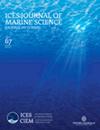对鱼类进行近实时资源管理的自动声学监测
IF 3.4
2区 农林科学
Q1 FISHERIES
引用次数: 0
摘要
发展中地区的淡水渔业为全球数百万人提供生计和营养。这些渔业往往数据贫乏,限制了渔业管理。洞里萨河上的柬埔寨季节性大平台渔业是东南亚监测最好的内陆渔业之一,但渔获量取样有限,也没有独立于渔业的监测。我们需要一个监测系统来描述鱼类洄游和死亡情况,该系统应具有成本效益,并可部署在基础设施最简陋的地区。我们将 Simrad 宽带收发器微型回声测深仪(200 千赫)、太阳能和物联网通信模块集成为一个自主、自动监测包,部署在上游和下游的商业捕鱼平台上。太阳能电池板和控制器为回声测深仪、通信模块和电池提供直流电,以便在黑暗时间供电。回声测深仪被设定为每小时以 1 赫兹的频率采样 15 分钟。通信模块是一个内置的蜂窝终端,可接入本地无线网络,将原始数据文件传输到数据服务器。数据从服务器下载,进行处理和分析。这种可扩展的系统提供了一种灵活的管理工具,可以部署在任何具有无线通信功能的地点。本文章由计算机程序翻译,如有差异,请以英文原文为准。
Automated acoustic monitoring of fish for near-real-time resource management
Freshwater fisheries in developing regions provide livelihoods and nutrition for millions of people worldwide. These fisheries are frequently data poor, which limits fisheries management. The seasonal Cambodian dai platform fishery on the Tonle Sap River is one of the best monitored inland fisheries in Southeast Asia, yet catch sampling is limited and there is no fishery-independent monitoring. A monitoring system is needed to characterize fish migration and mortality, be cost effective, and be deployable in areas with minimal infrastructure. We integrated a Simrad wide-band transceiver mini echosounder (200 kHz), solar power, and an Internet of Things communications module as an autonomous, automated monitoring package for the deployment on upstream and downstream commercial fishing platforms. The solar panel and controller supply direct current power to the echosounder, communications module, and battery for power during dark hours. Echosounders are programmed to sample at 1 Hz for 15 min every hour. The communications module is a built cellular endpoint that accesses a local wireless network to transmit raw data files to a data server. Data are downloaded from the server for processing and analysis. This expandable system provides a flexible management tool that can be deployed at any location with wireless communication capability.
求助全文
通过发布文献求助,成功后即可免费获取论文全文。
去求助
来源期刊

ICES Journal of Marine Science
农林科学-海洋学
CiteScore
6.60
自引率
12.10%
发文量
207
审稿时长
6-16 weeks
期刊介绍:
The ICES Journal of Marine Science publishes original articles, opinion essays (“Food for Thought”), visions for the future (“Quo Vadimus”), and critical reviews that contribute to our scientific understanding of marine systems and the impact of human activities on them. The Journal also serves as a foundation for scientific advice across the broad spectrum of management and conservation issues related to the marine environment. Oceanography (e.g. productivity-determining processes), marine habitats, living resources, and related topics constitute the key elements of papers considered for publication. This includes economic, social, and public administration studies to the extent that they are directly related to management of the seas and are of general interest to marine scientists. Integrated studies that bridge gaps between traditional disciplines are particularly welcome.
 求助内容:
求助内容: 应助结果提醒方式:
应助结果提醒方式:


